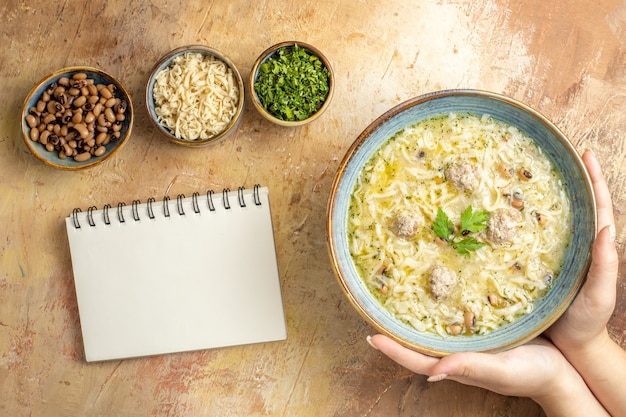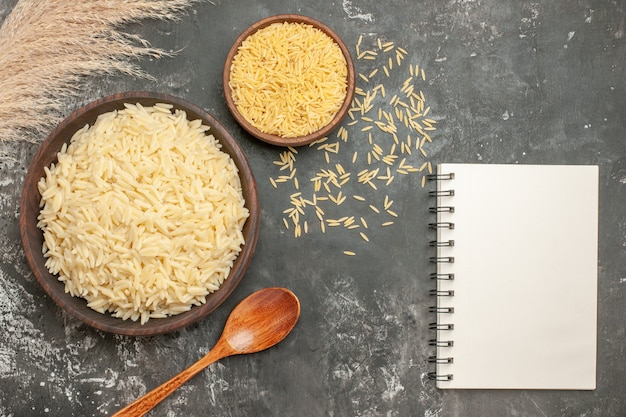orzo pasta, with its delightful rice-shaped form, is a true kitchen chameleon. It’s a versatile little pasta that can be dressed up or down, transforming into a comforting side dish, a vibrant salad, or the star of a hearty soup. But like any good chameleon, getting orzo just right requires a bit of finesse. I'm here to guide you through the art of crafting the perfect al dente orzo, a feat that'll leave you wanting seconds (and maybe even thirds).
Part 1: Choosing the Right Orzo - It's All in the Details

Orzo: A Short History
Before we dive into the cooking, let's take a moment to appreciate orzo itself. This delightful little pasta, resembling a grain of rice, is a true Italian invention. Born in the heart of Italy, orzo is crafted from durum wheat semolina, a choice ingredient that gives it that lovely, firm texture. It's typically quite small, but you can find larger "jumbo" versions, which make a nice change of pace.
Now, I know you might be tempted to confuse orzo with other "rice-shaped" pasta like "risoni" and "orzo gigante," but they are different characters in the pasta world. Those are larger, chunkier pastas, more suited for hearty dishes. We're focusing on the classic, petite orzo for this guide.
A Feast for the Senses: Exploring Orzo's Many Forms
When it comes to orzo, you're spoilt for choice! There's the basic, plain orzo, a blank canvas for all your culinary creations. But then there are flavored versions, a delightful array of tastes. Imagine the zest of spinach orzo, the sun-kissed tang of tomato orzo, or even the dark intrigue of black orzo. For me, plain orzo is the ultimate workhorse, but those flavored varieties are perfect for adding a touch of magic to your dish.
Organic Orzo: A Taste of Nature
If you're a health-conscious soul, you'll be happy to know that you can find organic orzo. It's made with durum wheat semolina that hasn't been exposed to pesticides or herbicides. It's a good option if you're looking for a more natural, wholesome approach to your cooking.
Fresh Orzo: A Rare Find
Now, here's a fun fact. Fresh orzo is a thing! But finding it might feel like embarking on a treasure hunt. You might stumble upon it at some specialty stores or farmers' markets, but it's not as common as the dried variety. Fresh orzo cooks up fast, but it doesn't have the same firm texture as its dried counterpart. For my everyday orzo adventures, dried orzo is the reliable companion.
Part 2: Mastering the Art of cooking orzo: A Step-by-Step Guide

The Right Pot: A Foundation for Success
Let's start with the essentials. You need a pot that's spacious enough to comfortably hold the orzo and plenty of water. A large saucepan is perfect, but if you have a big stockpot lying around, it'll do the trick too. Remember, the general rule of thumb is about 6 quarts of water for every pound of pasta.
Salt the Water: A Flavor-Boosting Ritual
This might sound like a simple step, but trust me, salting the water is a must! It adds flavor to the pasta, which is especially important when you're using plain orzo. Think of it as seasoning the pasta as it cooks, a secret ingredient for deliciousness. Use about 1 tablespoon of salt for every 4 quarts of water.
Boiling Point: The Key to Even Cooking
Next, bring the water to a rolling boil. This ensures the water is hot enough to cook the orzo quickly and evenly. Imagine each little orzo piece getting a gentle but powerful bath in the boiling water.
Adding the Orzo: A Slow and Steady Approach
Now, gently add the orzo to the boiling water. Adding it slowly helps prevent the water from cooling down too quickly. It also helps ensure that the orzo cooks evenly, preventing some pieces from getting overcooked while others are still raw.
Stirring and Cooking: A Dance of Flavors
Give the orzo a good stir to prevent it from sticking together, creating a clump of pasta instead of perfectly separated pieces. Then, cook the orzo according to the package directions. Generally, orzo takes around 8 to 10 minutes to cook, but always check the package instructions.
The Al Dente Test: Achieving Pasta Perfection
Here's where things get exciting. You want to test the orzo for al dente. This means cooked through but still with a slight bite to it. It's a delicate dance between cooked and raw, achieving that perfect balance of texture. The best way to test is to grab a piece of orzo and give it a taste. It shouldn't be too soft or mushy, nor should it be overly firm.
Part 3: Beyond the Basics: Orzo's Everyday Essentials

Storing Orzo: Keeping Your Pasta Fresh
Okay, we're talking about cooking, but it's always good to know how to store your orzo to keep it fresh. Store it in an airtight container in a cool, dry place. It'll stay good for up to 6 months. Just avoid storing it near strong-smelling foods like garlic or onions, as they can impart their aromas to the pasta.
Freezing Orzo: A Time-Saving Trick
Life gets busy, I know. Freezing orzo can be a lifesaver! Simply place it in a freezer-safe bag and freeze for up to 6 months. Thaw it overnight in the refrigerator before using. It won't have the exact same texture as freshly cooked orzo, but it's still a great option when you need a quick meal.
Reheating Orzo: Bringing Back the Flavors
Sometimes you find yourself with leftover orzo. The easiest way to reheat it is to toss it with a bit of olive oil and heat it in a skillet over medium heat. You can also microwave it, but it won't have that same satisfying texture.
Part 4: Orzo: The Versatile Culinary Star
Orzo in Salads: A Symphony of Textures and Flavors
I'm a big fan of salads, and orzo is a wonderful addition. It adds a satisfying heartiness and a delightful texture to any salad. It's especially good in salads with grilled chicken, vegetables, and a zesty lemony vinaigrette. I love making a big bowl of orzo salad with roasted vegetables, fresh herbs, and a light vinaigrette for a quick and satisfying lunch or dinner.
Orzo in Soups: Comforting and Delicious
Orzo can also be added to soups. It brings a touch of substance and a pleasing chewy texture to the broth. I particularly love orzo in tomato soup, chicken noodle soup, or even lentil soup. Orzo can also be added to creamy soups, like butternut squash or cauliflower soup, for a more substantial meal.
Orzo in Risotto: A Surprising Transformation
Now, here's a fun twist! Orzo can be used as the base for a creamy risotto. It might seem unconventional, but it works surprisingly well. You can use orzo to create a rich risotto with mushrooms, asparagus, or even shrimp. Follow the same basic steps as you would for traditional risotto, but use orzo instead of arborio rice.
Orzo in Bakes: Hearty and Delicious
Orzo can even be the star of a baked dish. It's a fantastic base for casseroles and pasta bakes. Mix it with vegetables, cheese, and your favorite sauce, then bake it until it's bubbly and golden brown. A classic combination is orzo with a creamy tomato sauce, mozzarella, and spinach.
Part 5: orzo recipes: A culinary adventure
Here are a few recipes to get your orzo journey started:
Easy Orzo Salad
1 pound orzo pasta, cooked al dente
1 cup chopped cucumber
1/2 cup chopped red onion
1/2 cup chopped fresh parsley
1/4 cup olive oil
2 tablespoons lemon juice
1 tablespoon red wine vinegar
Salt and pepper to taste
Cook the orzo according to package directions. Drain and rinse with cold water. In a large bowl, combine the cooked orzo, cucumber, red onion, and parsley. In a small bowl, whisk together the olive oil, lemon juice, red wine vinegar, salt, and pepper. Pour the dressing over the salad and toss to coat. Serve immediately or refrigerate for later.
Creamy Tomato orzo soup
1 tablespoon olive oil
1 onion, chopped
2 cloves garlic, minced
1 (28-ounce) can crushed tomatoes
4 cups chicken broth
1/2 cup heavy cream
1/2 cup cooked orzo
Salt and pepper to taste
In a large pot or dutch oven, heat the olive oil over medium heat. Add the onion and cook until softened, about 5 minutes. Add the garlic and cook for 1 minute more. Stir in the crushed tomatoes, chicken broth, and heavy cream. Bring to a simmer and cook for 15 minutes. Stir in the cooked orzo and season with salt and pepper. Serve hot.
Orzo with Lemon and Herbs
1 pound orzo pasta, cooked al dente
1/4 cup olive oil
2 cloves garlic, minced
1/4 cup chopped fresh basil
1/4 cup chopped fresh parsley
2 tablespoons lemon juice
Salt and pepper to taste
In a large bowl, combine the cooked orzo, olive oil, garlic, basil, parsley, and lemon juice. Season with salt and pepper. Toss to coat. Serve immediately or refrigerate for later.
Part 6: Orzo: Tips from My Kitchen
As a seasoned orzo cook, I've picked up some tips along the way:
Don't overcook the orzo. Aim for that perfect al dente texture, where there's a slight bite to it.
Don't be afraid to experiment with flavors. Orzo can be used in a variety of dishes, so be bold and creative in the kitchen.
Have fun! Cooking with orzo should be enjoyable.
Part 7: The Nutritional Value of Orzo
Fuel for Your Body
Orzo is a good source of carbohydrates, providing energy for your daily activities. It's also a source of fiber, which helps you feel full and can contribute to lower cholesterol levels. Orzo also offers a decent amount of protein, although not as much as some other grains.
Gluten-Free Options
If you're avoiding gluten, there's good news. You can find orzo pasta made with rice or quinoa. These gluten-free versions are just as versatile as traditional orzo and can be used in the same dishes.
Versatility at its Best
Orzo is incredibly versatile, as you've seen. It's perfect for salads, soups, risottos, bakes, and so much more. It's also a convenient choice for quick and easy meals.
Part 8: FAQs: Solving Your Orzo Dilemmas
1. What is the best way to cook orzo?
The package directions are a great starting point, but here are some tips to elevate your orzo game:
Use plenty of water (about 6 quarts for every pound of pasta).
Salt the water generously (about 1 tablespoon of salt for every 4 quarts of water).
Bring the water to a rolling boil before adding the orzo.
Cook the orzo for 8-10 minutes, or until it's al dente.
2. How do I know when orzo is cooked?
The best indicator is to taste it! It should be tender but still have a slight bite. You can also check if it's cloudy in the center. If it's still translucent, it needs a little more cooking time.
3. What are some good recipes for orzo pasta?
The world of orzo recipes is vast! Here are a few to get you started:
Orzo Salad with Grilled Chicken and Vegetables: A classic for summer barbecues.
Creamy Tomato Orzo Soup: Perfect for a comforting winter meal.
Orzo with Lemon and Herbs: A simple and delicious side dish for any meal.
4. Can I freeze orzo pasta?
Yes, you can freeze cooked orzo pasta. Make sure it cools completely before freezing. It'll last in the freezer for up to 3 months.
5. Is orzo pasta gluten-free?
Traditional orzo pasta is not gluten-free. But you can find gluten-free options made with rice or quinoa.
Part 9: Final Thoughts: Embark on Your Orzo Journey
There you have it, my ultimate guide to cooking perfect orzo pasta. Now, go forth and experiment! Have fun with different flavors and techniques. You might even stumble upon a new favorite orzo recipe. And when you do, be sure to share it with me! Happy cooking!
Everyone is watching

Prime Rib Roast Cooking Time Chart: Per Pound Guide
Cooking TipsPrime rib roast. Just the name conjures images of lavish dinners, crackling fires, and hearty laughter. It’s ...

How Long to Bake Potatoes in the Oven (Perfect Every Time)
Cooking TipsBaked potatoes are a staple in my kitchen. They're incredibly versatile, delicious, and surprisingly easy to m...

Perfect Rice Every Time: The Ultimate Guide to Cooking Rice
Cooking TipsAs a self-proclaimed foodie, I've always been a bit obsessed with rice. It's the foundation of countless cuisi...

The Ultimate Guide to Cooking Asparagus: Tips, Techniques, and Recipes
Cooking TipsAsparagus. The mere mention of this spring delicacy conjures up images of vibrant green spears, crisp and burs...

Ultimate Guide to Cooking the Perfect Thanksgiving Turkey
Cooking TipsThanksgiving. Just the word conjures up images of overflowing tables laden with delicious food, the scent of r...
